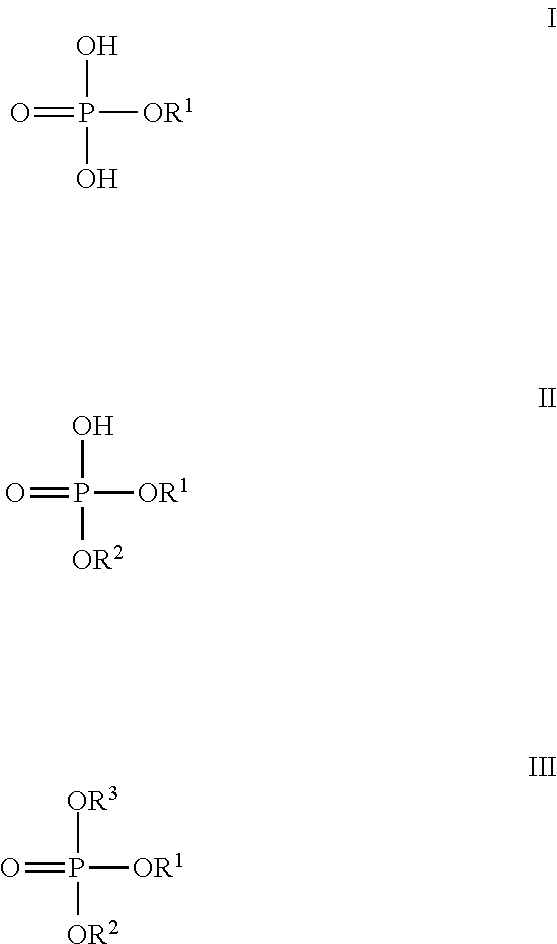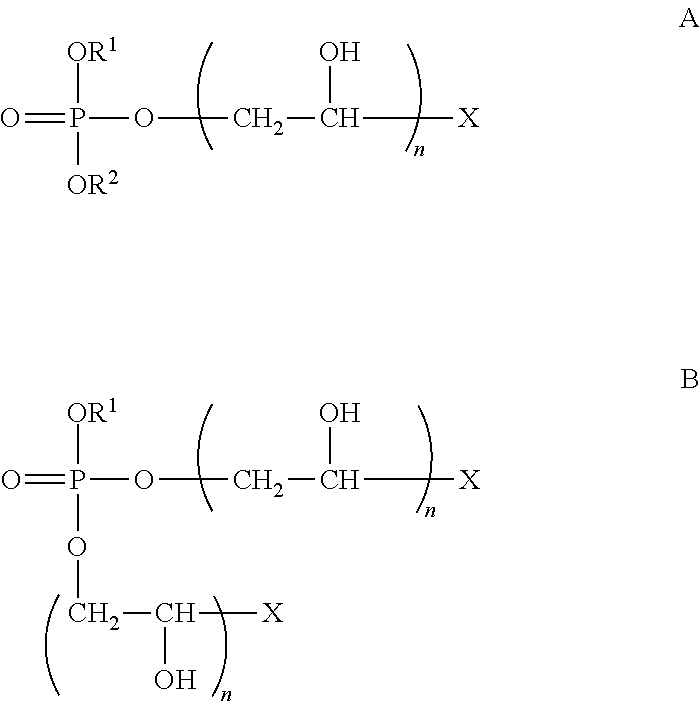It is widely known in the art that the
processing of
crude oil and its various fractions has led to damage to
piping and other associated equipment due to naphthenic acid corrosion.
These are corrosive to the equipment used to distill, extract, transport and process the crudes.
The difficulty observed in solving problems of naphthenic acid corrosion is that it is primarily difficult to access its concentration in the
crude oil, which is now estimated as
Total Acid Number (TAN) or
Neutralization Number.
The acids tend to concentrate in the heavier fractions during crude
distillation at various locations including furnace tubing, transfer lines, fractionating
tower internals, feed and
reflux sections of columns, heat exchangers, tray bottoms and condensers, and corrode such locations of the column.
Therefore, the
corrosion inhibitor suitable for one type of crude oil containing naphthenic acid may not be suitable for another type of crude oil containing naphthenic acid.
Further, the corrosivity of naphthenic acids is reported to be exceptionally serious in the presence of
sulfide compounds, such as
hydrogen sulfide, mercaptans, elemental
sulfur, sulfides, disulfides, polysulfides and thiophenols.
The naphthenic acid corrosion has also been reported to occur in
carbon steel or ferritic steel furnace tubes and
tower bottoms.
The alloys employing from 1.25% Cr to 12% Cr, or perhaps even higher amounts unfortunately show little to no resistance to naphthenic acid corrosion.
It has been observed that at elevated temperatures, the corrosion inhibitors demonstrate poor
thermal stability, and get decompose and deposited on surfaces of the reactor /
distillation unit, and thereby cause
fouling problem.
However, one will not prefer the inhibitor if its higher amounts cause other disadvantages as in case of
phosphorus containing inhibitors described hereinbelow.
Further, the naphthenic acid corrosion gets exceptionally severe in the presence of
sulfur compounds, especially
hydrogen sulfide.
The
phosphorus content of the crude oil or feedstock to be treated and of the
corrosion inhibitor is known to impair the function of various catalysts or tend to poison the catalysts which are used to treat the crude oil / feedstock /
hydrocarbon streams, e.g., in fixed-
bed hydrotreaters and hydrocracking units.
This problem, therefore, is more severe when higher amounts of
phosphorus containing
corrosion inhibitor are to be employed to counter higher concentrations of naphthenic acid.
The crude oil processors, therefore, are always in dilemma to use the
phosphorus containing inhibitors, because associated problems thereto may render the over-all process ineffective and commercially unviable.
However, use of additional stabilizers may also render the over-all process commercially unviable.
However, it has been found that these inhibitors are, generally, less effective as compared to
phosphorus containing inhibitors, and therefore, are not preferred choice.
It may be noted that such methods not only increase the
processing time, but also increase the
processing cost, and therefore, make the process highly undesirable for commercial purpose, and therefore, such remedies are not the preferred one.
Therefore, if the corrosion inhibitor per se, like aliphatic or aromatic phosphate esters has higher acidity, then they tend to react with metallic surface of the reactor and form salts thereof, like phosphate salts from aliphatic or aromatic phosphate esters, which sometimes get deposited and thereby cause
fouling.
Thus, such inhibitors having higher acidity have serious problems and therefore, cannot be employed as naphthenic acid corrosion inhibitors, or at least cannot be considered as preferred choice of the industry.
However, blending has not been reported to be successful in preventing naphthenic acid corrosion.
Even this approach has not been found to be effective to combat naphthenic acid corrosion which is severe at higher temperatures and more serious in presence of sulphur.
These inhibitors may be having good corrosion inhibition properties, but these tend to break down during high temperature applications with possible emission of obnoxious and toxic substances, therefore, are not preferred choice of the industry.
However, organic polysulfides are reported to be suitable only upto the temperatures of 500° F. The inventor of present invention believes such limitation of organic polysulfides is because of their poor
thermal stability.
Further, US'964 demonstrates [Table II of Example 2] that if one attempts to inhibit naphthenic acid corrosion either by employing phosphate ester alone or by employing
polysulfide alone, the corrosive activity is inhibited but not eliminated meaning thereby phosphate ester alone or
polysulfide alone are not effective to inhibit and eliminate the naphthenic acid corrosive activity.
This patent [see abstract and claim 1] also confirms that when one attempts to inhibit corrosion by employing either of thiophosphates or of pyrophosphates containing both
oxygen and
sulfur, or of
oxygen phosphates, the results are not encouraging.
US'447 also notes that many corrosion inhibitors capable of performing in non-aqueous systems and / or non-oxygenated systems perform poorly in aqueous and / or oxygenated systems.
In fact, it is common for inhibitors that which are very effective at relatively low temperatures have been found to become ineffective at temperatures such as the 175° C. to 400° C. encountered in oil refining.
At such temperatures, corrosion is notoriously troublesome and difficult to alleviate.
Further, there is no teaching that individually thiophosphates, pyrophosphates containing both
oxygen and sulfur, and oxygen phosphates would be effective against naphthenic acid corrosion at elevated temperature.
The inventor of present invention has found that these compounds have poor thermal stability, and tendency to decompose and get deposited on metallic surfaces of the reactor, and have
high phosphorus content, high acidity, and therefore, cannot be effective as naphthenic acid corrosion inhibitors.
The inventor of present invention has found that these compounds also have poor thermal stability, and tendency to decompose and get deposited on metallic surfaces of the reactor, and have
high phosphorus content, high acidity, and therefore, cannot be effective as naphthenic acid corrosion inhibitors.
Therefore, even US'049, US'050 and US'085 cannot be considered to disclose or suggest or teach use of phosphate esters as naphthenic acid corrosion inhibitor at elevated temperature during crude
oil processing.
As described herein, the use of phosphorus based compounds particularly, when these are to be employed in higher amounts, can cause impairing of catalyst activity or poising of catalyst.
The main problem, in addition to general problems of sulfur-based constituents, is that the suggested sulfur compounds are expensive, therefore, the process is not economically viable.
This publication also does not disclose or teach phosphate esters which can be effective at elevated temperature and demonstrate higher thermal stability and low acidity.
As this is aliphatic in nature and its molecular weight is likely to be very low, it is expected to be thermally less stable at elevated temperatures.
The proposed additives are non-polymeric in nature and the non-polymeric additives tend to break down at elevated temperature conditions resulting in formation of volatile products which tend to contaminate the
hydrocarbon stream.
Further, the non-polymeric compounds have poor efficiencies.
Therefore, their volatility and protection offered is not predictable.
Accordingly, it is understood from the foregoing description that present problem faced by the industry is that none of the additives of the prior art can be considered as preferred choice to inhibit naphthenic acid corrosion at elevated temperature in crude oil / hydrocarbon / feedstock
distillation / reactor column, because these have one or the other problem as described herein.
Further, the corrosion inhibitor so developed may comprise lower, but effective amounts of phosphorus.
 Login to View More
Login to View More 


